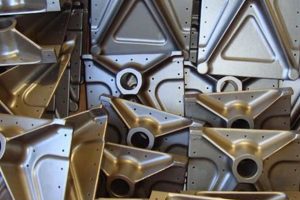The intentional combination of various metallic textures and tones within a culinary space represents a design approach that moves beyond monochromatic schemes. This involves incorporating hardware, fixtures, and decorative elements in different metals, such as stainless steel, brass, copper, or black iron, within the same room. An example includes pairing stainless steel appliances with brass cabinet pulls and a copper pendant light.
This design choice introduces visual interest and depth, preventing a kitchen from appearing sterile or one-dimensional. A considered assortment of metallic elements can enhance the overall aesthetic, creating a sophisticated and personalized environment. Historically, kitchens often featured a limited range of metal finishes, but contemporary design embraces eclecticism and individuality, leading to greater acceptance and popularity of diversified metallic elements.
Exploring the principles of balance and harmony in this design approach is key. Considerations such as understanding the color temperature of metals, establishing a dominant finish, and distributing metallic elements throughout the space are crucial for achieving a cohesive and visually appealing result. The following sections will delve into these aspects, providing practical guidance for implementing this design strategy effectively.
Practical Guidance for Varied Metallic Elements in Kitchen Design
Successfully integrating diverse metallic components into kitchen design necessitates careful planning and execution. The following guidance provides a framework for achieving a balanced and aesthetically pleasing result.
Tip 1: Establish a Dominant Metal. Designate one metal finish as the primary element, using it for larger installations like appliances or the kitchen faucet. This provides a unifying foundation for the design.
Tip 2: Consider Color Temperatures. Metals possess either warm (gold, brass, copper) or cool (stainless steel, chrome, nickel) undertones. Balance these temperatures strategically. For example, warm brass hardware can offset the coolness of stainless steel appliances.
Tip 3: Utilize the Rule of Three. Incorporate at least three different metal finishes to create visual interest and prevent the space from appearing overly matched or predictable. However, avoid excessive variation that can lead to a cluttered aesthetic.
Tip 4: Repeat Finishes Throughout the Space. Distribute each metal finish across multiple areas of the kitchen. Repeat the same finish on cabinet hardware and light fixtures to establish a sense of coherence.
Tip 5: Pay Attention to Undertones. Analyze the undertones of the cabinetry and countertops to ensure the metal finishes complement the existing color palette. For example, brushed nickel may pair well with cool-toned grey cabinets.
Tip 6: Balance with Neutral Elements. Utilize neutral colors in the backsplash, walls, and countertops to provide a visual respite from the metallic elements. This ensures the metals stand out without overwhelming the space.
Tip 7: Vary Textures and Sheens. Combine polished, brushed, and matte finishes to add dimension and visual interest. For example, pairing polished chrome faucets with brushed stainless steel appliances introduces subtle variation.
By adhering to these principles, designers and homeowners can confidently integrate diverse metallic finishes to create a kitchen that is both visually striking and functionally harmonious.
The subsequent section will explore specific metal finish combinations and design styles to further illustrate the practical application of these concepts.
1. Dominant metal selection
The selection of a dominant metal finish functions as a foundational element when diverse metallic elements are incorporated into kitchen design. The presence of a prevailing metal establishes a visual anchor, providing a sense of cohesion and preventing the space from appearing chaotic. Without a clear primary metal, the assorted metallic elements may lack unity, resulting in a disjointed aesthetic. For instance, in a kitchen featuring stainless steel appliances, designating stainless steel as the dominant metal allows other metals, such as brass or copper hardware, to serve as complementary accents rather than competing focal points.
The dominant metal selection influences the perceived style and tone of the kitchen. Stainless steel, for example, contributes to a contemporary or industrial feel, while brushed nickel may lend itself to a more transitional design. The choice also impacts the selection of secondary metals. A kitchen with a black stainless steel appliance suite might incorporate matte black hardware and lighting fixtures to maintain a cohesive aesthetic. The deliberate establishment of a dominant metal guides subsequent design decisions, ensuring that all elements work in harmony to achieve a specific visual goal.
In summary, dominant metal selection serves as a guiding principle in the application of diversified metallic features within a kitchen environment. It is a critical factor in achieving visual balance, stylistic consistency, and overall design coherence. Challenges may arise in striking a balance between the dominant and secondary metals, but understanding this relationship is essential for achieving a sophisticated and intentionally designed culinary space.
2. Color temperature balance
Within the context of incorporating varied metallic elements into kitchen design, color temperature balance refers to the strategic combination of metals with warm (e.g., gold, brass, copper) and cool (e.g., stainless steel, chrome, nickel) undertones. The effective mixing of these temperatures is crucial for achieving a harmonious aesthetic. An imbalance can result in a kitchen that feels either sterile and cold or overly heavy and dated. For instance, a kitchen dominated by cool stainless steel appliances can benefit from the addition of warm brass cabinet hardware or a copper pendant light to introduce visual warmth and prevent a monochromatic feel. The consequence of neglecting this balance is a potentially disjointed and uninviting space.
Practical application of color temperature balance involves assessing the existing features of the kitchen, such as cabinetry color and countertop material. If the cabinetry is a warm-toned wood, the introduction of cool stainless steel accents can provide a contrasting element that enhances the overall design. Conversely, if the kitchen features cool grey or white cabinetry, warm metal finishes can add much-needed visual interest and prevent the space from feeling sterile. Understanding the inherent color temperature of each metal finish is paramount. For example, brushed nickel, with its neutral undertones, can serve as a bridge between warm and cool metals, facilitating a smoother transition between disparate elements. Designers must also consider lighting, as the color temperature of light bulbs can significantly impact the perceived warmth or coolness of the metal finishes.
In summary, color temperature balance is a critical component of successful mixed-metal kitchen design. The strategic application of warm and cool metals is essential for achieving visual harmony and creating an inviting atmosphere. Challenges may arise in discerning subtle differences in metal undertones, but a keen understanding of color theory and careful consideration of existing kitchen features will contribute to a well-balanced and aesthetically pleasing outcome. This understanding is the backbone of the entire design endeavor.
3. Finish distribution uniformity
Finish distribution uniformity, when applied to the practice of integrating diverse metallic elements into kitchen design, dictates the balanced and consistent allocation of each selected metal finish throughout the space. This principle aims to prevent a disjointed or haphazard appearance that can arise when metallic elements are not strategically placed. An unbalanced distribution can lead to visual clutter and disrupt the overall aesthetic coherence of the kitchen. For example, if a brass finish is exclusively used on cabinet hardware but absent in lighting fixtures or other decorative elements, the design may appear incomplete or unintentionally asymmetrical. The deliberate repetition of each metal finish in various areas of the kitchen ensures that no single metal overwhelms the design, fostering a sense of visual harmony and planned integration.
Achieving finish distribution uniformity requires a comprehensive assessment of all kitchen components, including appliances, cabinetry hardware, lighting fixtures, plumbing fixtures, and decorative accessories. The selected metallic elements should be strategically repeated across these components to create a sense of visual rhythm and balance. For instance, if stainless steel appliances are the dominant metal, stainless steel accents should be incorporated into the lighting fixtures or decorative elements to reinforce the chosen theme. Conversely, introducing a contrasting metal finish, such as copper, requires careful planning to ensure its distribution complements the existing design without overwhelming the space. Examples include incorporating copper accents in pendant lights, small appliances, or decorative storage containers, and ensuring these elements are visually balanced within the kitchen layout.
In conclusion, finish distribution uniformity is a foundational principle that enables the successful execution of varied metallic elements within a kitchen environment. By ensuring the balanced and consistent allocation of each metal finish throughout the space, designers can create visually harmonious and intentionally designed culinary spaces. Challenges may arise in achieving perfect symmetry or avoiding an overly predictable pattern, but a conscious effort to distribute finishes strategically contributes to a sophisticated and unified aesthetic. The absence of this principle can result in visual chaos and a diminished overall design impact.
4. Textural variation integration
Textural variation integration, within the context of varied metallic components in kitchen design, denotes the purposeful combination of metal finishes with differing surface qualities to enhance visual interest and tactile appeal. The intentional juxtaposition of smooth, brushed, hammered, or patinated metals prevents a kitchen from appearing flat or monotonous. For instance, pairing polished chrome faucets with brushed stainless steel appliances creates a dynamic interplay of light and shadow, enriching the overall design. The absence of textural variation can render the space visually static and lacking in depth, undermining the potential benefits of incorporating multiple metal finishes.
The practical application of textural variation involves considering the inherent properties of each selected metal. Polished surfaces, such as chrome or highly polished brass, reflect light intensely and contribute to a sleek, modern aesthetic. Brushed finishes, including brushed nickel or stainless steel, offer a softer, more diffused reflection, creating a sense of warmth and subtlety. Hammered or patinated metals introduce tactile elements, adding character and visual depth. In a kitchen setting, a balance of these textures can be achieved by combining polished chrome fixtures with brushed stainless steel appliances and hammered copper accents. The careful selection and placement of these finishes ensures that each element complements the others, enhancing the overall design.
In conclusion, textural variation integration is an indispensable aspect of successful varied metallic features within a kitchen environment. By strategically combining metal finishes with differing surface qualities, designers can create visually dynamic and engaging spaces. Challenges may arise in balancing the various textures and avoiding an overly cluttered aesthetic, but a thoughtful approach to this principle is essential for achieving a sophisticated and intentionally designed culinary space. Ignoring this aspect results in a less visually appealing result.
5. Undertone color harmony
Undertone color harmony is a crucial consideration when incorporating varied metallic elements into kitchen design. The undertone, the subtle underlying color cast within a metal’s finish, directly influences how it interacts with other materials in the space, particularly cabinetry, countertops, and backsplashes. Disharmony in undertones can result in a visually jarring effect, undermining the intended aesthetic. For example, pairing warm-toned gold hardware with cool-toned grey cabinets lacking warm undertones can create a clashing effect, while matching a warm metal with warm-toned wood fosters a cohesive and visually pleasing result. The intentional selection of metals that complement the existing undertones is essential for achieving a balanced and sophisticated outcome.
Practical application of undertone color harmony involves assessing the existing fixed elements in the kitchen. Cabinetry paint colors and countertop materials often possess distinct undertones, which may be warm (yellow, red, orange) or cool (blue, green, violet). Metals should be selected to either harmonize with or intentionally contrast these undertones. Stainless steel, with its neutral to cool undertones, generally pairs well with cooler color schemes but can also provide a crisp contrast to warmer palettes. Brass, with its warm undertones, adds richness and depth to kitchens with warm-toned woods or paint colors. The strategic use of a neutral metal, such as brushed nickel, can serve as a bridge between warm and cool elements, smoothing transitions and preventing visual discord. Consideration of lighting is also crucial, as artificial and natural light can accentuate or suppress undertones, influencing the overall perceived harmony.
In conclusion, undertone color harmony serves as a critical element in successfully integrating varied metallic elements within a kitchen environment. By carefully analyzing the undertones of existing materials and selecting metals that complement or intentionally contrast those undertones, designers can create visually cohesive and aesthetically pleasing spaces. While discerning undertones can present a challenge, the attentive application of color theory principles yields a significantly more refined result. Ignoring this critical aspect can diminish the quality and intentionality of the design scheme, leading to an inferior result.
Frequently Asked Questions
The following section addresses common inquiries and concerns related to the integration of varied metallic elements into kitchen design. These questions and answers provide guidance for achieving a balanced and aesthetically pleasing outcome.
Question 1: Is there a limit to the number of metal finishes that can be effectively incorporated into a single kitchen design?
While there is no strict numerical limit, it is generally recommended to limit the number of different metal finishes to three or four. Exceeding this number can result in a cluttered and visually chaotic aesthetic, detracting from the overall design coherence.
Question 2: How does one ensure that the selected metal finishes complement the existing cabinetry and countertop materials?
Prior to selecting metal finishes, a thorough assessment of the existing cabinetry and countertop materials is necessary. Identifying the undertones of these surfaces allows for the selection of metal finishes that either harmonize with or intentionally contrast these undertones, creating a cohesive design scheme.
Question 3: What is the role of lighting in showcasing mixed metal finishes in the kitchen?
Lighting significantly impacts the perceived appearance of metal finishes. The color temperature and intensity of lighting fixtures should be carefully considered to ensure that the metals are appropriately illuminated, highlighting their texture and color without creating harsh glares or washing out their inherent qualities.
Question 4: Is it acceptable to mix polished and brushed metal finishes within the same kitchen design?
Yes, mixing polished and brushed metal finishes is an effective way to add visual interest and depth to the kitchen. However, the distribution of these finishes should be carefully considered to maintain a balanced and cohesive aesthetic.
Question 5: What are some common mistakes to avoid when incorporating varied metallic components into a kitchen?
Common mistakes include neglecting to establish a dominant metal finish, failing to consider the undertones of existing materials, and unevenly distributing the chosen metal finishes throughout the space. Avoiding these pitfalls is crucial for achieving a successful design.
Question 6: How can one incorporate varied metallic elements into a small kitchen without overwhelming the space?
In smaller kitchens, it is advisable to use a limited number of metal finishes and to ensure that these finishes are distributed evenly throughout the space. Opting for lighter, more reflective metals can also help to maximize the perceived size and brightness of the kitchen.
In summary, carefully considering the number of finishes, existing materials, lighting, finish types, common mistakes, and space constraints are vital for successful integration of diverse metal finishes in a kitchen.
The following section will discuss considerations of metal finishes with various style.
Conclusion
The integration of varied metallic elements within the kitchen represents a design approach demanding careful consideration of balance, harmony, and existing architectural features. Key elements include dominant metal selection, color temperature balance, finish distribution uniformity, textural variation integration, and undertone color harmony. Successful application necessitates a strategic approach, moving beyond arbitrary choices to create a cohesive and visually sophisticated space.
Mastering the art of strategically mixing metal finishes in kitchen environments offers the opportunity to transform a functional space into a design statement. By prioritizing thoughtful planning and meticulous execution, designers and homeowners can achieve a kitchen that reflects both aesthetic sensibilities and a nuanced understanding of design principles. Future trends suggest a continued exploration of innovative metal finishes and combinations, further enhancing the potential for personalized and visually compelling culinary spaces. The informed combination of diverse metallic elements remains a cornerstone of contemporary kitchen design.







